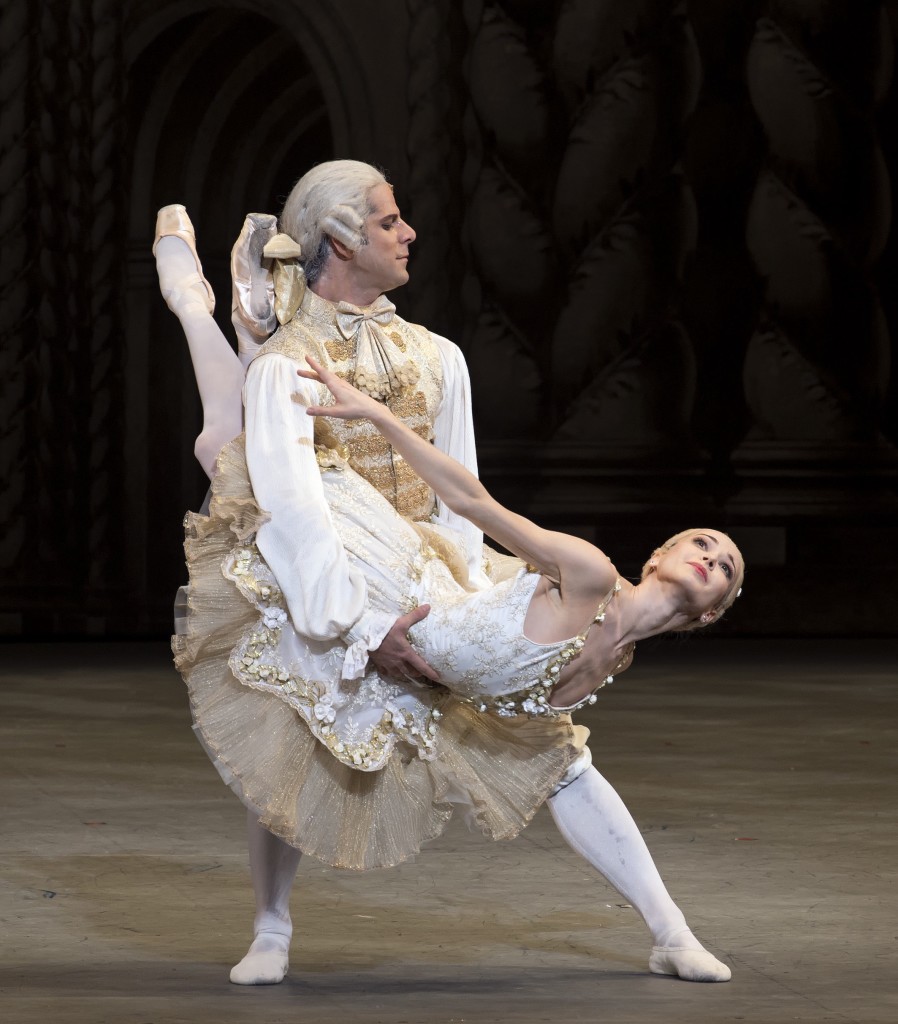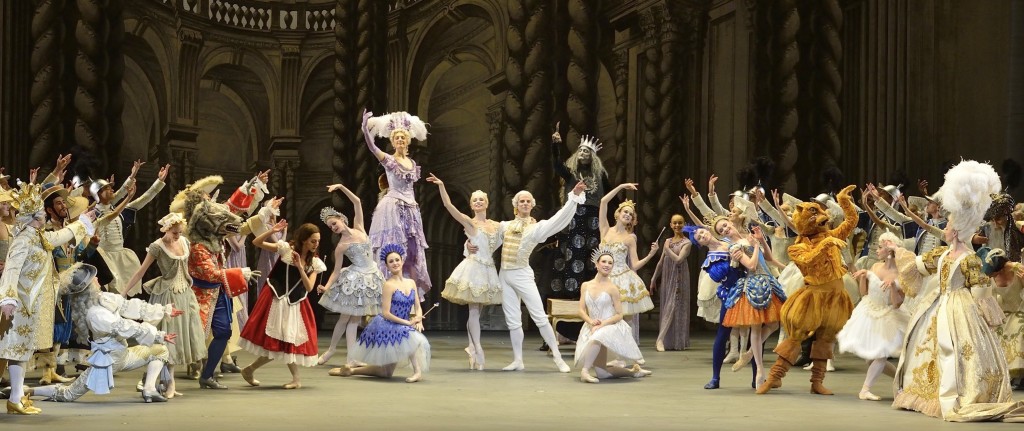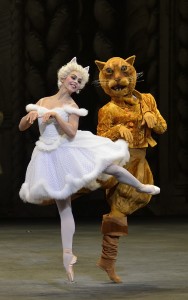What does it mean that American Ballet Theatre has come out with a big new Sleeping Beauty? The production of Ratmansky’s new/old staging cost six million dollars (half of which is to be covered by the co-commissioning company, La Scala Ballet). I know I’m not supposed to think about money, just art. But while watching this production (twice), I couldn’t help but notice how extravagant it is—400 costumes and 210 wigs—compared to how little relevance the ballet holds for us today.
Tchaikovsky’s music is lushly beautiful. With its danceable waltzes and big dramatic bursts, it expresses the clash between anger and harmony that drives the narrative. But the tale is about an ancient kingdom that has only one worry: to make sure the daughter doesn’t get hold of a spindle. It’s not a ballet that stirs complex emotions or stimulates a train of thought about life’s dilemmas.

ABT in Ratmansky’s Sleeping Beauty: a 6 million dollar tab. All photos by Gene Schiavone.
The other ABT classics are perennials because they each have something that speaks to us today. The violence between the warring factions of Romeo and Juliet is always painfully relevant. Prince Siegfried in Swan Lake is searching for something that’s more spiritual than his materialistic upbringing; and Odette, who feels trapped, has to rely on a man’s faithfulness. We learn from Giselle that class differences can forbid one from marrying for love, and that recognizing your mistakes can change your life.
And then there’s The Sleeping Beauty. Sure, it’s about the battle between good and evil, but what’s the message? Be careful not to incur the wrath of a powerful person? Of course no ballet can be reduced to a single message—but this one comes close.
I applaud Ratmansky for immersing himself in the Stepanov notation and drawings of Petipa’s original 1890 version. It’s interesting that he was guided more by his passion for ballet history than his personal choreographic desires. I also applaud the dancers, especially Diana Vishneva and Marcelo Gomes, who imbued the leading roles with a shared spirituality. (Similar, as I wrote in 2011 in Dance Magazine, to the partnership of Alina Cojocaru and Johan Kobborg when they danced these roles in ABT’s last version.)

Diana Vishneva as Princess Aurora and Marcelo Gomes as Prince Désiré: shared spirituality.
But at a time when people around the globe are plagued by violence, racial issues, and environmental degradation, a story that focuses solely on the aristocracy can only serve as an escape. But is there some undercurrent to this type of escape? Is it also some kind of reinforcement of complacency? The audience can get swept up in the glory of Tchaikovsky’s music and the detail of Petipa’s steps, as researched by Ratmansky and his wife Tatiana. But in the end the ballet represents a very privileged population.
One of my colleagues suggested taking pleasure in the precision and communicative aspects of the dancing. But I find the predictable structure of the choreography a deterrent. When I see the many repetitions in the Garland Waltz, I imagine Petipa saying to his dancers, “Do three of these and one of those.” In steps as well as story, The Sleeping Beauty doesn’t measure up to the other classics.
In her Dance Tabs review, Marina Harss writes, “The real challenge isn’t replicating the steps but bringing them to life, and through them, channeling the spirit of the age. In this, it seems to me that Ratmansky has succeeded, producing a ballet that glows from within.”
I agree that the dancing is stamped with the spirit of the times. ABT has given us a piece of history, and there is value in that. Ballet historians are soaking this moment up. But for some of us, it’s like seeing lithographs of dainty ballerinas come to life. In this Sleeping Beauty I missed dancing that extends into space; I missed the directness that Balanchine has given us. Dance evolves for a reason. It adjusts to how cultures and bodies change.
Maybe I’ll get used to this Sleeping Beauty as one flavor in the pack of ABT’s repertoire—the old world flavor. But if this reconstruction was intended to be the centerpiece of ABT’s 75 years, it seems a misstep to me.

Finale of The Sleeping Beauty, with Lilac Fairy and Carabosse in background.
I can’t help but point out that the previous, equally anticipated new Sleeping Beauty for ABT premiered only eight years ago. It was assembled by esteemed dance artists Gelsey Kirkland and Kevin McKenzie, along with Michael Chernov, none of whom is a choreographer. It kept some traditional things and changed or condensed others. It created some beautifully tender moments that propelled the story. (Again, I cite my posting from 2011.) To my mind its worst mistake was not giving the prince a physical struggle to reach his goal. He did not have to fight to arrive at the castle.
And the Ratmansky version makes the same mistake. It’s too easy for Prince Désiré to find the love of his dreams. If he had to overcome the barrier to the castle, if he had to work hard and sweat, if he had to shed his princeliness for a few minutes, the ballet would offer some sense of a catharsis. In the New York City Ballet’s version, the prince whacks away the choking vines that have encrusted the castle for a hundred years. By the time he reaches Aurora, we feel he has earned her love.

Isadora Loyola and Sean Stewart as the White Cat and Puss-in-Boots, Photo by Gene Schiavone.
But Petipa/Ratmansky’s Prince Désiré has no such grit. He has technical grit, e.g. difficult petit allegro, but no emotional grit. He sails easily, guided by the Lilac Fairy, from his vision of Aurora to the bedroom of Aurora. All the royal characters retain their royal calm in every scene. This production seems to say that beauty and harmony only reside in a smoothly running aristocracy.
That said, I was delighted that Ratmansky reinstated the storybook characters that add such fun to Aurora’s Wedding. The White Cat and Puss-in-Boots are particularly welcome, with their witty clawing and flirting.
So….will there be another Sleeping Beauty in eight years?
Featured Uncategorized 15
Thank you for your review. I am very interested in how this project with Ratmansky / ABT / La Scala works as next season Ratmansky will be recreating Swan Lake with Zürich Ballet / La Scala. I hope that he learns from this project and we will have a wonderful Swan Lake adaptation in Zürich. Fingers crossed.
Hi Stephan, I saw Ratmansky’s Romeo and Juliet with National Ballet of Canada, and I’ve seen his Nutcracker with ABT several times. Both of those productions are magical in many ways and tell the story beautifully. So my guess is that his Swan Lake will also be wonderful. I hope he puts more of himself into it and less of Petipa. I wish I could come to Zürich to see it. Wendy
I hope you don’t mind, but I do disagree with your description of the point of The Sleeping Beauty. What struck me so strongly in this production (as in the glorious 1999 Mariinsky version) is how personal and timeless the story is. It isn’t really about abstract good and evil (unlike the more Romantic Swan Lake, where Rothbart is a destructive and irrational force of nature). Carabosse is the worst of human nature — vain, vindictive, insisting on justice, where Lilac stands for mercy and forgiveness. There are so many instances where mercy ultimately triumphs over justice — that is why the mime scene with the knitters is so crucial. The King (especially in the 1999) version argues for justice, since he has banned the knitting needles he must stick to his decision, while the Queen and the court beg for mercy, and ultimately win out, showing that this court is a truly good one. Even in the last act, the Ogre woman begs her husband to forgive Hop o’my Thumb. And, again in the 1999 version, it is clear that Aurora forgives Carabosse at the wedding, though the court does keep an eye on the wicked fairy. Evil isn’t completely destroyed (as in Swan Lake), it is contained. Sleeping Beauty’s theme isn’t some grand existential battle between good and evil, it is a very personal one, that each of us can choose mercy, can forgive Carabosse, and can earn our happiness. I find the Ratmansky version really quite subtle and profound.
I completely agree. And thanks for citing the 1999 version, for me still the best overall
I am glad Ratmansky cares enough about the art he practices in. He has and will always have a chance to show off of his own creations. Rarely would he have a chance to remind us where tradition ballet came from. I am glad ABT gave him this chance. We must look forward to where arts develop, as well as remember where it came from. Sometimes, I regret to think, in our western culture, we like to forget how it travelled through time. This version of “Sleeping Beauty” serves to remind us what is extraneous and what is precious. Granted, this commission may seem to be the wrong time to spend such an appalling sum. But when would be the right time? Isn’t it true that is precisely where the delicate balance of arts and commerce comes in?
I was just in NYC and saw ABT perform R&J instead of Sleeping Beauty. MacMillan’s R&J, ABT’s production of it, and Hee Seo as Juliet was breath taking, as was the rest of the cast. MacMillan’s choreography as produced by ABT is completely integrated into the story and gives the task of revealing the emotion to the dancers where it should be and really only can be. Many new interpretations of any of the classics are stripped of heart because we have become so focused on choreographers as stars that often the movement itself sticks out self-consciouslyas separate from the ballet.
Kathy, I am looking forward to seeing R & J too.
Not every ballet is going to be a psychological onion, such as “Manon”. Some are just for fun. Just like as in musical theater, not every book is going to be the psychological onion, such as “Sweeney Todd”.
Some musical theater will be as frothy as “Pirates of Penzance” and some ballet will be as frothy as “Sleeping Beauty”.
“Pirates” and “Beauty” can both be made freshly compelling to audiences with creative sets, costumes, orchestration, and choreography.
The 8 year old SB at ABT had many detractors, due to the Thomas Kinkaide-ish sets, and choices to axe certain beloved choreographic details.
I applaud ABT for taking the risk, and setting themselves apart in a city that has a traditional NYCB production, and many visits from big companies with traditional SBs in tow.
I agree, in general, that there is room for both frothy and serious on our dance landscape. I do prefer the NYCB production, for its sets that allow you to see time pass in a poetic way, and for the reason I stated. It’s also not bogged down by extra Lilac Fairy assistants etc. For me, it tells the story better. If ABT’s new version lasts, then I’ll be happy for them. But I wish they would look at some of their choices in plot development and costuming.
Wendy,
Totally agree with you…and further, I don’t believe “he” is a good storyteller classics revisions (where old-story is already there) or otherwise…you should read my review on BRIGHT STREAM! Spend on new stories – perhaps American ones – for a new time…
I would argue that this production has the virtue of illuminating the history and development of the art of ballet—challenges our eye and our understanding of Petipa. It makes us question a lot of the technical aspects that we take for granted, and helps us hear the music in a different way. (In a way, it’s like the early-music movement which has allowed us to hear Baroque and pre-baroque music in a new way.) The fact that this re-think was undertaken by a choreographer with a deep feeling for the style, a rich imagination, and a sensitive musicality makes it all the more rewarding. But at the end of the day, whether one likes the result is a question of taste.
I think ABT/Ratmansky’s/La Scala’s new SB has opened a very very interesting discussion. I myself feel as Mary does, that SB is the greatest of ballets – because in the music, and the dancing, is encoded all of the regret, anguish, nostalgia, denial, grief, about old ways passing (which they always do). And in this case, in SB, they almost pass violently – because of evil. At the time SB was made, 1890, Vsveolozhky and Tchaikovsky too, were aware that the Russian empire they’d served, lived and had their careers in, was doomed. When and how it would fall was not clear. The production I believe was born as a lament for the soon-to-be-lost beauty of a doomed culture – lost because of stupidity (the SB king is kind of stupid, as was Alexander III – forceful but stupid). But Aurora is beautiful & alive! If only she had become Tsarina instead of meek Nicholas II. The ballet (that abstract entity) speaks to all nostalgia – all desire to protect the fragile patterns & customs of a decadent/beautiful/unjust culture that must go. The Ratmansky/Fullerton reconstruction moves me very much, for this reason, and because I imagine Ratmansky, a child of Soviet Russia, rolling back the layers of Russia ballet history (our history too, since Tsarist Russia & Petipa preserved & enriched ballet) to find the greatest vanished production of imperial times (his heritage), and – against all odds – bring it to life. That could not be done in Soviet times, nor could it be done now in today’s Russia – without political overtones. Here he can do this, thanks to somebody’s donation. And the dancers I saw, throughout the corps up to principal level, went with him, giving their all.
I do appreciate hearing about the historical context from you (and Mary and Marina). I too am moved by Ratmansky’s attempts to dig beyond the Soviet past. I’ll try to keep all this in mind when I see SB next time it comes around. Thank you.